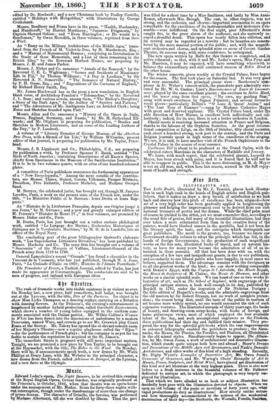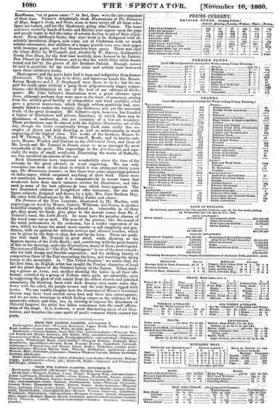filiP 3rtg.
TZLITSTRATIVR ART,
THE Idle .Rookh, illustrated by Mr. J. Tenniel, places book illustra- tion in such, high rank in the bands of English artists and 'English Pub- lishers, that it Makes us draw a, deep breath of satisfaction as, we look back and observe how thia.piteli of excellence has been, ateinedeehciw art of a very high', order has been, gradually applied in heightening the pleasure and, helping the improvement ever to be derived from our rich
national treasures of poetry and the dem& While the chief palm roust of course be yielded to the artist, yet we must remember that, according to
the usual fate of genius, full many of the beautiful illu.stratiene, had they ever taken a more, substantial form than in the creative fancy of the painter, would have blushed unseen in the portfolio, had, it not been fer the literary spirit, the taste, and the enterprise which distinguish our great publishers. The merit is the greater, too, because we know our Government steadily refuses to adopt the principle_which hes led, in the hands of foreign Governments, to the production of such magnificent works on the fine arts, illustrated books of travel, and. on natural, hie- tory, as hare for many years become the admiration of all of us in- terested in these pursuits. All that has been clone with us, with the exception of a few rare and insignificant grants, is due to our publishers, and secondarily to our liberal public who have happily, in most cases we believe, supported them. The advantage remains with the foreigners as to all the greatest works of the kind ; we can show nothing comparable with Denon's Egypt, with the Voyage de r Astrolabe, the Mimes Royale, the Mimeo de Sculpture of M. Clairac, the Music de Florence, and other works on a similar splendid scale. We can boast of one or two works il- luetrative of art, such as The School. of Rupliael, with engravings of the principal antique statues, a book welt enough in its day, published by Boydell in 1781, under the inspection of Sir Nicholas Dorigny ; the folio edition of Hogarth's.works, and, the admirable engravings front the old masters by Sir Robert Strange, but no work of complete preten- sions; the reason being that, until the taste of the public in, matter's of art became more widely spread, no Q130 wouldtineeunte; the risk of such expensive ventures. The illustrated am:male of thirty yews ago, the books of _beauty, and drawing.room. scrap-books, with books of foreign and home picturesque views, most of which employed the best available talent of the day, and smell accomplished engravers as the Findens, these publications had their (ley and fulfilled their mission. They pre- pared the way for the splendid gift-books which the vast improvements in coloured lithography enabled the publishers to produce ; the Alma- necks, the Ileum the Diaries, the Parables, and Psalters, alt ilhuniliated in the old missal styles. Simultaneously began to appear, The Alhunt- bra, by Mr. Owen Jones, a work of architectural and decorative illustra- tion' which stands quite unique both here and abroad' Shaw's Dresses andHecorationa of the .MitkIle Ages and Benaissancc, and Nash's Domestic _architecture' and other works of this kind of a high standing. Recently, Mr. Digby Wyatt's Examples of Decoratire Art, Mr. Owen Jones's Grammar of Ornament, and Mr. Waring's Choice itamples of Art in Mosaic, Fresco, Sculpture, and Metal Work, have placed art illustration of this kind and art literature at the very highest point. There is also now before us a fresh instance in the beautiful volumes of Mr. Falkener dedicated to antique art, in which the photograph ie very largely em- ployed for illustration.
That which we have alluded to as book or subject illustration has decidedly kept pace with the illustration devoted to objects. When we open an old volume of the poets or novelists of forty years ago, what vapid productions do duty as illustrations! Haw utterly unlike nature and how thoroughly accommodated to the notions of the academical doctrinaires of their day—the Stothards, the Westlake Fluselbe Smirk"
Kauffman, ,I et id genus mune : " in fact, these were the art-composer:it of their time. Turner's delightfully fresh illustrations of The'.251eastires of Hope, , Roger's Italy, and Scott, seem to have swept off all these Boho-
l:title art-taaters, awn:et the illustrators going' a truer and The uer arid more masterly hands of Leslie and hfaclite ne*t appear upon the page
and people!begin' to:feel the :value of artistic feeling in,aid;of their enjoy bent Eve* ehildren's Wye,' that were Wont to be disfigured with ab- tiOlutely:iniant&Ous thapea;.new come ,out at Chriebnis with. so Magi
artistic adornment, that children of a larger growth turn over their pages
With immense gusto, and feel themselves boys again. There was ,reiik MI ai,ant-Killer 'hy M'ConiSell', and jledilin by W. Harvey, Goldsmith's Coady Two Shoes, for the first time Worthily done honour to by Dalsieli Tom Throati by Hablot Browne, and in fact the whole fairy' eirele draWn round and fair by :the graver of the Brothers Dalziel. Enough cannot be saidin -gratitude for the excellent sense and artistic taste bestowed upon these, children's books. Shakespeare and ,t e poets harel had to bear sad indignities from former illinitratOrs. 'TheTti- was to bedone, and dixterena hands.like Messrs. Rfnny,N.Redpws frnd . P. Step off, were Acre to do it ; but for our part WE dottld spate without a !pang' those preposterontly stagey compo- latintni--the filtnitiipie0es in 'one' of the best of our editions of aoke- sp4ares 3fr. John Gilbert's illustrations were a great advance upOn these, although perhaps' they were open to the fault of sameness; arising , front-the artiat's great frieility of composition and hand qualities ;t hat gave a general mannerist:a, which though seldoni positively bad, con-
stantly failed!to realize the variety, the :freshness, and yet the universal
truth of ,the great dramatist. •Mr. Gilbert's style, however, has founded a• legionof initilitors and picture literature, in which Ahere may be
abctalsarew of mediooriky,- but not certainly of a low-art tendency.' Whore prodnetione may be classed with the fugitive illustrative art of the day, though the latter occasionally brings forth some really fine ex- amples :.-.) ,elser ankkaldidrawing, es, well as achievements in wood
apgravingOtthe highest ,Class. The works of the brothers, Messrs. G. and W. Thottutj, J.1Y,.',Xinton;;M'Corinell, ge4de, and in marine sub- jects, Messrs. Weeclon'and'Dimean.in the://histrated News, and those of Mr. Leech and Mr..Tenniel in Fiureit, occur to us as amongst the Most remarkable Of the geed. The engravings in the Art-Joni-tie', and espe- cially the aeries of ;small: wood-cuts illustrating the Works of Raffaelle, are also excellent speCithens.of the art.
Book illustrations have improved wonderfully since the time of the Minna:s, by the.' at advance in wood, engraving. We can . only
remember one book of the kind in which it was attenaz,ted thirty years
ago,, The _Missionary Annual; in this there were some engravings printed on india-paper, which surpassed-anything of their' kind. These were not continued, . however, and .it-. is comparatively in recent times that wocd-reftbi :have...done much eminent service for illustration, and take rank in: some . of the beat editions de luxe which have appeared. The two illustrated' editions! of Longfellow- offer 'instances ; ' the one with figure subjects, designed-and 'drawn by a lady,: Mrs. Jane Benham Hay, the other with illustrations by Mr..13irket Fester and others. - The 'Princess of the Poet Laureate, illustrated by Mr: 'Midis% with epgrevings,pn wood by Messrs, Palziel, Williaint, and Green, is another
beautiful eiarkile, Which. should be referred: to Admirable as all these
are, they must, we think, give. place to the newest comer from Mr. J. Tenniel'a hand, the-Id/le Rookh: In -none have the peculiar charms of
the wood come out so well. ,The tone of the picture, like the sound of the wood instruntents . in the orchestra, has a tender expression of its own, Which' we fancy the Metal never equals-a soft timpliciti,and gen-
tletteat, :With an aptaiesa.fOr delicate:40ra* arid allusive touches, which Can be given by the flute or oboe,:but-aot:by the horn. These'are quali! tieis' that stand. Mr.': Tenitielin eiciff 'iCcad; while :showing us the Eastern fancies of the Lai& _Rookie ; and, combining with the great beauty etline in his drawing, make-the illustrations, many of them; perfect genis. - •ThereSeue of Hinda in ".T.b.e Fire Worshippers" is one of the most remark. able for bold design 'and'foreible expression ;' and for striking beauty of aimposition those Of. the Peri succouring the hero, and watching the dying lovers in the moonlight. In " The Veiled Prophet," we notice that, for the first tiMe, in English artist hat caught the Persian character of head and the pliant figure-of the Oriental:beauty of the- hOrem. Zeliea Steil.; lug a glance- at Asia:, sad: another she:Wing' the ladies in all their idle
'beauty, -atfenlled by-et-group of Nubian sltive-girla,' are admirable, even t4 suggesting the glow of rich.'eelOtir froMthe silken shawls and jewelled
ornaments, the blushing feces with dark dreamy eyes, made..more .sha- dewy with the cohol,:the 'purple tresses and the.rosy fingers tipped with henna. -We can -readily imagine how the illustrator of Moore't luxuriant
aeams may have been earned ,away here and there into extravagance,
and we see some drawings in which feeling verges ortthe vielence of the spasmOdic-schooli and thus, too, in striving to express the daintiness of Oriental languor, the artist -has ,alien actnellines into' the small affeeta- ticins of the stage. It is,' however, a most'. fascinating piece of art illus- tration, and breathasthe same spirit Of poetic romance'which created-the



























 Previous page
Previous page